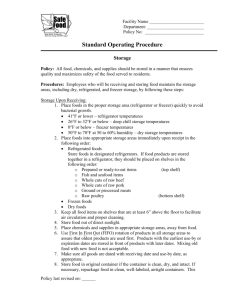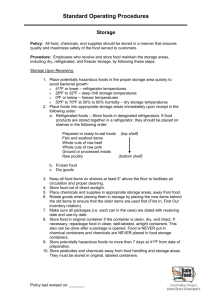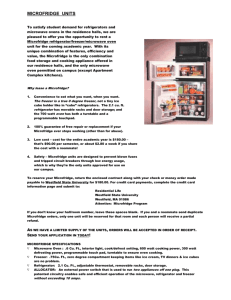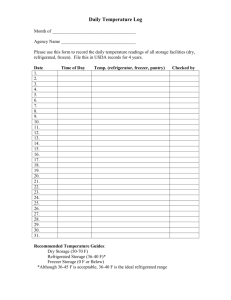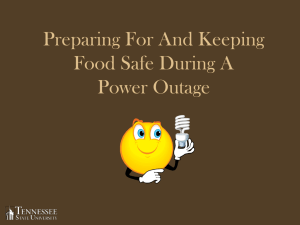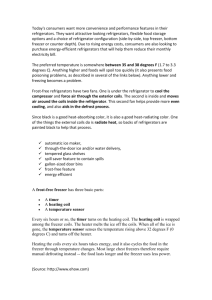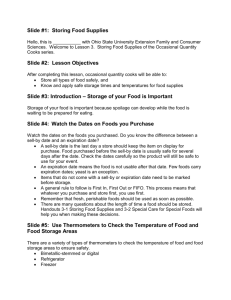Maintaining Safe Storage Temperatures
advertisement
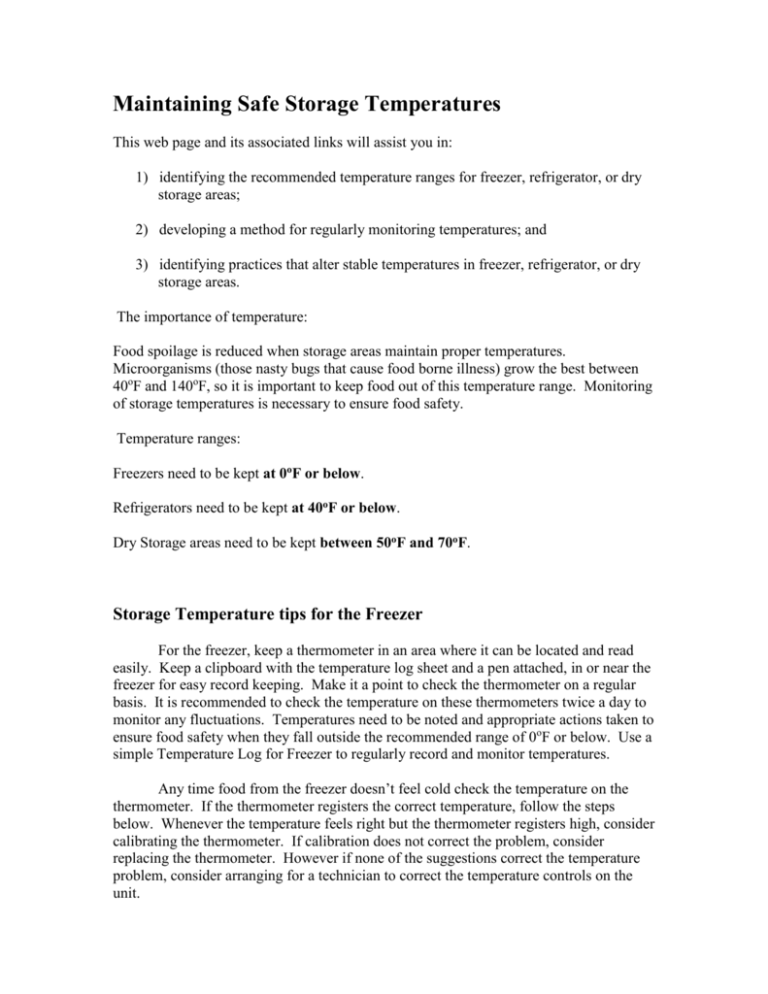
Maintaining Safe Storage Temperatures This web page and its associated links will assist you in: 1) identifying the recommended temperature ranges for freezer, refrigerator, or dry storage areas; 2) developing a method for regularly monitoring temperatures; and 3) identifying practices that alter stable temperatures in freezer, refrigerator, or dry storage areas. The importance of temperature: Food spoilage is reduced when storage areas maintain proper temperatures. Microorganisms (those nasty bugs that cause food borne illness) grow the best between 40oF and 140oF, so it is important to keep food out of this temperature range. Monitoring of storage temperatures is necessary to ensure food safety. Temperature ranges: Freezers need to be kept at 0oF or below. Refrigerators need to be kept at 40oF or below. Dry Storage areas need to be kept between 50oF and 70oF. Storage Temperature tips for the Freezer For the freezer, keep a thermometer in an area where it can be located and read easily. Keep a clipboard with the temperature log sheet and a pen attached, in or near the freezer for easy record keeping. Make it a point to check the thermometer on a regular basis. It is recommended to check the temperature on these thermometers twice a day to monitor any fluctuations. Temperatures need to be noted and appropriate actions taken to ensure food safety when they fall outside the recommended range of 0oF or below. Use a simple Temperature Log for Freezer to regularly record and monitor temperatures. Any time food from the freezer doesn’t feel cold check the temperature on the thermometer. If the thermometer registers the correct temperature, follow the steps below. Whenever the temperature feels right but the thermometer registers high, consider calibrating the thermometer. If calibration does not correct the problem, consider replacing the thermometer. However if none of the suggestions correct the temperature problem, consider arranging for a technician to correct the temperature controls on the unit. For the freezer, it is important to close the door securely every time you open, close, enter, or exit the unit. Do not overload with food, or put hot food directly into it. Overloading can cause a restriction in airflow, which will cause the unit to function improperly. When hot food is placed directly into the unit this can cause the temperature inside the cooling unit to rise. When removing food from the freezer, remember your mother, “Don’t stand there with the door open!” Get the food you need and do it quickly. Storage Temperature tips for the Refrigerator For safety, it is important to verify the temperature of the refrigerator. Refrigerators should be set to maintain a temperature of 40 °F or below. Some refrigerators have built-in thermometers to measure their internal temperature. For those refrigerators without this feature, keep an appliance thermometer in the refrigerator to monitor the temperature. This can be critical in the event of a power outage. When the power goes back on, if the refrigerator is still 40 °F, the food is safe. Foods held at temperatures above 40 °F for more than 2 hours should not be consumed. Appliance thermometers are specifically designed to provide accuracy at cold temperatures. Be sure refrigerator/freezer doors are closed tightly at all times. Don't open refrigerator/freezer doors more often than necessary and close them as soon as possible. Safe Handling of Foods for Refrigerating Hot food can be placed directly in the refrigerator or it can be rapidly chilled in an ice or cold water bath before refrigerating. Cover foods to retain moisture and prevent them from picking up odors from other foods. A large pot of food like soup or stew should be divided into small portions and put in shallow containers before being refrigerated. A large cut of meat or whole poultry should be divided into smaller pieces or placed in shallow containers before refrigerating. Placement of Foods The temperature in a refrigerator should be 40 °F or below throughout the unit, so that any place is safe for storage of any food. Raw meat, poultry, and seafood should be in a sealed container or wrapped securely to prevent raw juices from contaminating other foods. Some refrigerators have special features such as adjustable shelves, door bins, crispers, and meat/cheese drawers. These features are designed to make storage of foods more convenient and to provide an optimal storage environment for fruits, vegetables, meats, poultry, and cheese. Storage Temperature tips for the Dry Storage Area Many items such as canned goods, baking supplies, grains, and cereals may be held safely in dry storage areas. The guidelines below should be followed: Keep dry storage areas clean with good ventilation to control humidity and prevent the growth of mold and bacteria. Store dry foods at 50°F for maximum shelf life. However, 70°F is adequate for dry storage of most products. Place a thermometer on the wall in the dry storage area. Check the temperature of the storeroom daily. Store foods away from sources of heat and light, which decrease shelf life. Store foods off the floor and away from walls to allow for adequate air circulation.

